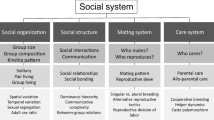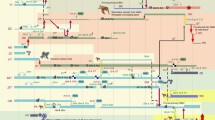Abstract
Multilevel or modular societies characterize a range of mammalian taxa, allowing social groups to fission and fuse in response to ecological factors. The modular society of hamadryas baboons has previously been shown to consist of 4 levels: troop, band, clan, and one-male unit (OMU). A recent study by Hill et al. (Biology Letters 4:748–751, 2008) revealed a mean scaling ratio across successive levels of multilevel societies of ca. 3; this was consistent across elephants, orca, geladas, and hamadryas baboons. Here we reanalyze the scaling ratio for hamadryas baboons with previously unavailable data from Filoha. Our analysis revealed a mean scaling ratio for hamadryas of 3.28 without data on the hamadryas clan layer of organization at Filoha, but a ratio of 6.17 with these data included. This discrepancy is due to the large clan and band sizes at Filoha yielding a larger than average gap between the OMU and the clan. Further analysis revealed subsets of OMUs within clans, suggesting a 5th level of society in this population. When this 5th layer of social structure is included in the analysis, the scaling ratio at Filoha is consistent with that of other hamadryas populations and other taxa. These results suggest that a consistent mammalian scaling ratio can be used to detect previously hidden levels of organization within societies and to predict their sizes in taxa for which detailed behavioral data are not available.

Similar content being viewed by others
References
Abegglen, J. J. (1984). On socialization in hamadryas baboon. London: Associated University Presses.
Al-Safadi, M. M. (1994). The hamadryas baboon, Papio hamadryas (Linnaeus, 1758) in Yemen (Mammalia: Primates: Cercopithecidae). Zoology in the Middle East, 10, 5–16.
Bergman, T., & Beehner, J. (2004). Social system of a hybrid baboon group (Papio anubis × P. hamadryas). International Journal of Primatology, 25, 1313–1330.
Biquand, S., Biquand-Guyot, V., Boug, A., & Gautier, J.-P. (1992). Group composition in wild and commensal hamadryas baboons: a comparative study in Saudi Arabia. International Journal of Primatology, 13, 533–543.
Brent, L. J. N., Lehmann, J., & Ramos-Fernandez, G. (2011). Social network analysis in the study of non-human primates: a historical perspective. American Journal of Primatology, 73, 720–730.
Colmenares, F. (2004). Kinship structure and its impact on behavior in multi-level societies. In B. Chapais & C. M. Berman (Eds.), Kinship and behavior in primates (pp. 242–270). New York: Oxford University Press.
Cui, L., Huo, S., Zhong, T., Xiang, Z., Xiao, W., & Quan, R. (2008). Social organization of black-and-white snub-nosed monkeys (Rhinopithecus bieti) at Deqin, China. American Journal of Primatology, 70, 169–174.
Grueter, C. C., & Zinner, D. (2004). Nested societies: convergent adaptations of baboons and snub-nosed monkeys? Primate Report, 70, 1–98.
Hamilton, M. J., Milne, B. T., Walker, R. S., Burger, O., & Brown, J. H. (2007). The complex social structure of hunter-gatherer social networks. Proceedings of the Royal Society B: Biological Sciences, 274, 2195–2202.
Hill, R. A., & Dunbar, R. I. M. (2003). Social network size in humans. Human Nature, 14, 53–72.
Hill, R. A., Bentley, R. A., & Dunbar, R. I. M. (2008). Network scaling reveals consistent fractal pattern in hierarchical mammalian societies. Biology Letters, 4, 748–751.
Hoogland, J. L. (1995). The black-tailed prairie dog: Social life of a burrowing animal. Chicago: University of Chicago Press.
Kirkpatrick, R. C., & Grueter, C. C. (2010). Snub-nosed monkeys: multilevel societies across varied environments. Evolutionary Anthropology, 19, 98–113.
Kummer, H. (1968). Social organization of hamadryas baboons: A field study. Chicago: University of Chicago Press.
Kummer, H. (1971). Primate societies: Group techniques of ecological adaptation. Wheeling, IL: Harlan Davidson.
Kummer, H., Banaja, A. A., Abo-Khatwa, A. N., & Ghandour, A. M. (1981). Mammals of Saudi Arabia: primates: a survey of hamadryas baboons in Saudi Arabia. Fauna of Saudi Arabia, 3, 441–471.
Liu, Z., Ding, W., & Grueter, C. C. (2007). Preliminary data on the social organization of black-and-white snub-nosed monkeys (Rhinopithecus bieti) at Tacheng, China. Acta Theriologica Sinica, 27, 120–122.
Manno, T. G. (2008). Social networking in the Columbian ground squirrel, Spermophilus columbianus. Animal Behaviour, 75, 1221–1228.
Nagel, U. (1973). A comparison of anubis baboons, hamadryas baboons and their hybrids at a species border in Ethiopia. Folia Primatologica, 19, 104–165.
Pines, M., Saunders, J., & Swedell, L. (2011). Alternative routes to the leader male role in a multi-level society: follower versus solitary male strategies and outcomes in hamadryas baboons. American Journal of Primatology, 73(7), 679–691.
Ren, R. M., Su, Y. J., Yan, K. H., Li, J. J., Zhou, Y., Zhu, Z. Q., Hu, Z. L., & Hu, Y. F. (1998). Preliminary survey of the social organization of Rhinopithecus [Rhinopithecus] roxellana in Shennongjia Natural Reserve, Hubei, China. In N. G. Jabonski (Ed.), The natural history of the doucs and snub-nosed monkeys (pp. 269–277). Singapore: World Scientific Press.
Ren, R., Yan, K. H., Su, Y. J., Zhou, Y., Li, J. J., Zhu, Z. Q., Hu, Z. L., & Hu, Y. F. (2000). A field study of the society of Rhinopithecus roxellanae. Beijing: Beijing University Press.
Schreier, A. L. (2009). The influence of resource distribution on the social structure and travel patterns of wild hamadryas baboons (Papio hamadryas) in Filoha, Awash National Park, Ethiopia. Ph.D. thesis, City University of New York.
Schreier, A. L. (2010). Feeding ecology, food availability, and ranging patterns of wild hamadryas baboons at Filoha. Folia Primatologica, 81, 129–145.
Schreier, A., & Swedell, L. (2008). Use of palm trees as a sleeping site for hamadryas baboons (Papio hamadryas) in Ethiopia. American Journal of Primatology, 70, 107–113.
Schreier, A. L., & Swedell, L. (2009). The fourth level of social structure in a multi-level society: ecological and social functions of clans in hamadryas baboons. American Journal of Primatology, 71, 948–955.
Sigg, H., & Stolba, A. (1981). Home range and daily march in a hamadryas baboon troop. Folia Primatologica, 26, 40–75.
Stammbach, E. (1987). Desert, forest, and montane baboons: Multilevel societies. In B. B. Smuts, D. L. Cheney, R. M. Seyfarth, R. W. Wrangham, & T. T. Struhsaker (Eds.), Primate societies (pp. 112–120). Chicago: The University of Chicago Press.
Sugawara, K. (1979). Sociological study of a wild group of hybrid baboons between Papio anubis and P. hamadryas in the Awash valley. Primates, 20, 21–56.
Swedell, L. (2000). Two takeovers in wild hamadryas baboons. Folia Primatologica, 71, 169–172.
Swedell, L. (2002a). Affiliation among females in wild hamadryas baboons (Papio hamadryas hamadryas). International Journal of Primatology, 23, 1205–1226.
Swedell, L. (2002b). Ranging behavior, group size and behavioral flexibility in Ethiopian hamadryas baboons (Papio hamadryas hamadryas). Folia Primatologica, 73, 95–103.
Swedell, L. (2006). Strategies of sex and survival in Hamadryas baboons: Through a female lens. Upper Saddle River, NJ: Prentice Hall.
Swedell, L. & Plummer, T. (this issue). A papionin multi-level society as a model for early hominin evolution. International Journal of Primatology.
Swedell, L., & Schreier, A. (2009). Male aggression towards females in hamadryas baboons: Conditioning, coercion, and control. In M. N. Muller & R. Wrangham (Eds.), Sexual coercion in primates: An evolutionary perspective on male aggression against females (pp. 244–268). Cambridge, CA: Harvard University Press.
Swedell, L., Hailemeskel, G., & Schreier, A. (2008). Composition and seasonality of diet in adult male hamadryas baboons: preliminary findings from Filoha. Folia Primatologica, 79, 476–490.
Swedell, L., Saunders, J., Schreier, A., Davis, B., & Pines, M. (2011). Female “dispersal” in hamadryas baboons: transfer among social units in a multi-level society. American Journal of Physical Anthropology. doi:10.1002/ajpa.21504.
Whitehead, H., Waters, S., & Lyrholm, T. (1991). Social organization of female sperm whales and their constant companions and casual acquaintances. Behavioral Ecology and Sociobiology, 29, 385–389.
Wolf, J. B. W., Mawdsley, D., Trillmich, F., & James, R. (2007). Social structure in a colonial mammal: unraveling hidden structural layers and their foundations by network analysis. Animal Behaviour, 74, 1293–1302.
Xiang, Z. F. (2005). The ecology and behavior of black-and-white snub-nosed monkeys (Rhinopithecus bieti, Colobinae) at Xiaochangdu in Honglaxueshan National Nature Reserve, Tibet, China. Ph.D. thesis, Kunming Institute of Zoology.
Yang, S. (2000). Habitat, diet, range use and social organization of Rhinopithecus bieti at Jinsichang. Ph.D. thesis, Kunming Institute of Zoology.
Zhang, P., Watanabe, K., Li, B., & Tan, C. (2006). Social organization of Sichuan snub-nosed monkeys (Rhinopithecus roxellana) in the Qinling Mountains, Central China. Primates, 47, 374–382.
Zhou, W. X., Sornette, D., Hill, R. A., & Dunbar, R. I. M. (2005). Discrete hierarchical organization of social group sizes. Proceedings of the Royal Society B: Biological Sciences, 272, 439–444.
Zinner, D., Peláez, F., & Torkler, F. (2001). Distribution and habitat associations of baboons (Papio hamadryas) in Central Eritrea. International Journal of Primatology, 22, 397–413.
Acknowledgments
We thank the Ethiopian Wildlife Conservation Authority for permission to conduct research at Filoha. The City University of New York PSC-CUNY Research Award Program (award no. 66588-0035 to L. Swedell), the New York Consortium in Evolutionary Primatology, and the City University of New York Ph.D. Program in Anthropology provided funding. For support and assistance in the field, we thank Getenet Hailemeskel, Demekech Woldearegay, Teklu Tesfaye, Getu Mamush, Denberu Tesfaye, Getu Kifle, Julian Saunders, Christine Tuaillon, and Matt Klein. We thank Cyril Grueter and 3 anonymous reviewers for comments that have greatly improved this manuscript.
Author information
Authors and Affiliations
Corresponding author
Rights and permissions
About this article
Cite this article
Schreier, A.L., Swedell, L. The Socioecology of Network Scaling Ratios in the Multilevel Society of Hamadryas Baboons (Papio hamadryas hamadryas). Int J Primatol 33, 1069–1080 (2012). https://doi.org/10.1007/s10764-011-9572-1
Received:
Accepted:
Published:
Issue Date:
DOI: https://doi.org/10.1007/s10764-011-9572-1




